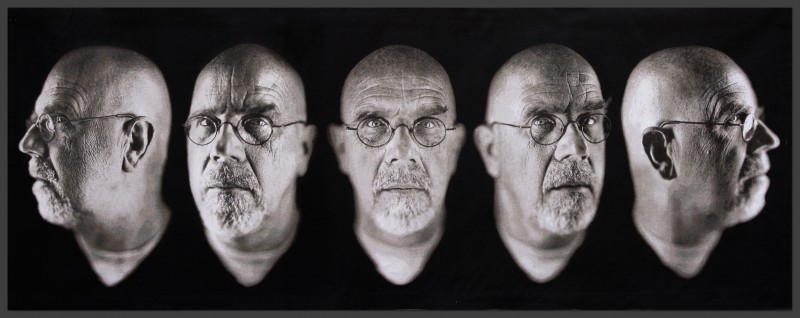
Jacquard tapestry
State I: 75 x 185 in; State II: 79 x 229 in
State I: Edition of 6; State II: Edition of 6
With Self-Portrait/Five Part, Chuck Close sets a new standard for fine art tapestries. In this technically virtuosic work, a near-panoramic series of five self-portraits are woven together in a single Jacquard tapestry. The work’s muralistic scale harkens back to the tapestries which covered the walls of medieval castles, but its minutely detailed imaging of light and shadow on Close’s face could only be the result of contemporary electronic weaving technology and sophisticated digital translation techniques. Close and Magnolia Editions’ Donald Farnsworth have been working to refine and perfect Self-Portrait/Five Part since 2007, weaving nearly a dozen proofs using different color palettes until they reached the extraordinary level of fidelity and precision visible in the approved tapestry.
Self-Portrait/Five Part is available in two limited editions:
State I: 75 x 185 in. Edition of 6
State II: 79 x 229 in. Edition of 6
* * *
For almost four decades, Chuck Close has created portraits from tonal grids of fingerprints, pointillist dots, brushstrokes, paper pulp and countless other media. It was only natural that the artist’s ambitions led him to tapestry, a classical and difficult medium posessing Close’s signature tension between abstracted units (woven thread combinations) and a legible, unified surface.
Close’s signature method can be considered, for discussion’s sake, as follows: a subject is photographed; the photographic image is then translated into a large oil painting on canvas via a systematic, grid-based rubric. In many of his recent paintings, each cell in the grid is initially filled with a particular color, arbitrarily chosen and intentionally distant from the color desired. As the painting progresses, a series of other colors are overlaid or concentrically inserted into the cell, creating combinations which alter the way we perceive its overall color. “Optical blending” is the name for the phenomenon by which the human eye amalgamates neighboring colors into a single hue. A viewer’s encounter with any work by Close hinges on this process, for the eye works first on a micro level to combine the colors in each cell into a single bit of color information, and then on a macro level, to add up the mosaic of individual bits, as the abstraction of the grid coalesces into an image of a human face.
The rigor and mathematical precision of the grid has prompted numerous writers to label Close’s process as “scientific.” The flip side of this is the unexpected musicality afforded by the grid. Its repetitions create a precise and regular rhythm while the variations in color represent a series of literally chromatic modulations. “I’m working with the color equivalent of a musical chord, a kind of color chord,” says Close of his compositions. The layered, concentric colors within each cell are reminiscent of the stacked thirds and flatted fifths of a chord progression, their passages of dissonance and tension ultimately resolved in a sophisticated harmonic balance.
The translation that is so fundamental to Close’s process – the filtration of a given subject, first through a photographic lens and then through the grid system – necessarily involves an alchemical transition from one state to another. His tapestry portraits are among the most extreme examples of this change of states. Here, Close takes a photographic image and transforms it into a woven textile, a grid composed of optically blended warp and weft threads. The images in the tapestries begin as daguerreotype plates: at 8.5 x 6.5 inches, the daguerreotypes must be seen up close to be seen at all. Their silvery faces are among the most reflective, glossiest surfaces you can find and are almost difficult to see clearly, since while you scan the image you cannot help but see your own face mirrored back at you. The tapestries, by contrast, are nearly ten feet tall and completely matte. A daguerreotype plate is fragile and easily fingerprinted; the tapestries are durable textiles that practically beg to be touched. What’s more, they are the opposite of reflective – they absorb; in this case, not light, but sound and heat.
To create his woven editions, Close works with Magnolia Editions’ Donald Farnsworth to develop a digital instruction set, called a weave file, translating the daguerreotype image into data which can be read by an electronic Jacquard loom in Belgium. This customized Dornier loom uses 17,800 Italian dyed cotton warp threads woven at 75 shots per cm, generating colors via different combinations of eight warp thread colors and the ten weft thread colors selected by Farnsworth. A color palette must be developed for each tapestry edition containing all of the necessary values. A weave file is then constructed based on this palette. “There is more raw data in one weave file,” explains Farnsworth, “than if you combined the text of all of Shakespeare’s plays.”
– Nick Stone
show prices
Prices and availability are subject to change without notice.The copyright of all art images belongs to the individual artists and Magnolia Editions, Inc.
©2003-2025 Magnolia Editions, Inc. All rights reserved. contact us
